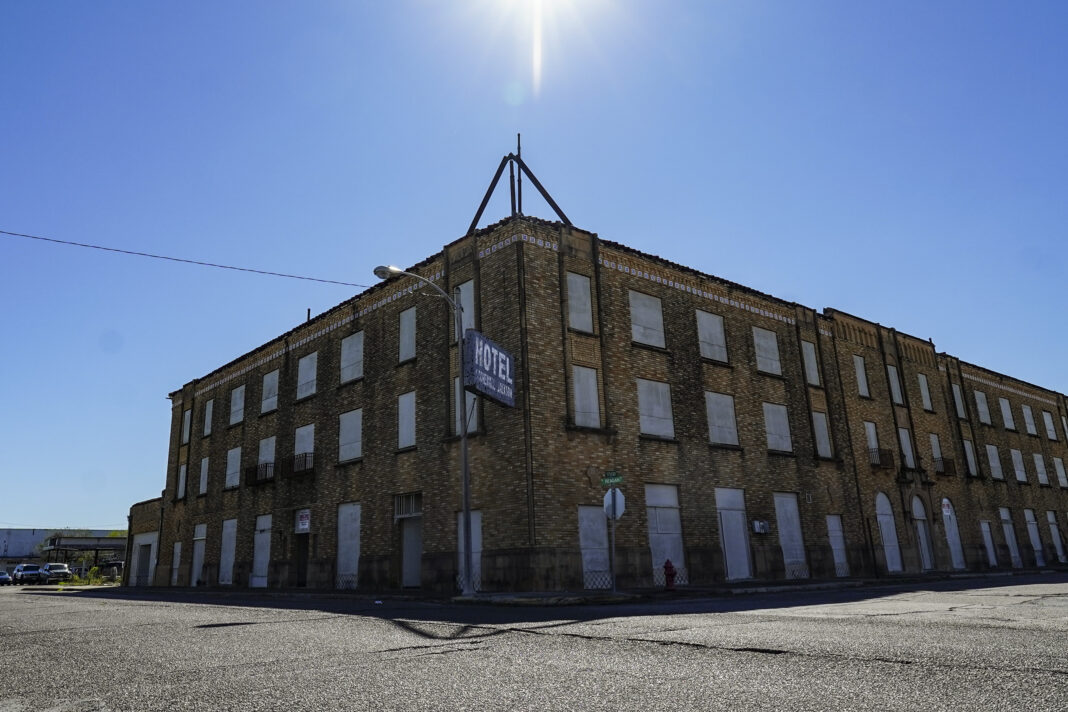SAN BENITO — For decades, dreams have helped keep the iconic Stonewall Jackson Hotel standing.
Nearly 10 years after its purchase, the San Benito Housing Authority is still trying to breathe new life into the cherished landmark whose boarded-up windows hold a treasure trove of memories and architectural majesty chronicling the city’s heyday.
“It’s just important for us to try to keep it alive,” Mayor Rick Guerra said. “We want to see if we can get it up and going again.”
At the housing authority, officials aren’t giving up — despite the proposed renovation project’s estimated $7 million price tag.
In October, the agency’s request for proposals from developers — part of a plan to apply for federal tax credits to help fund the project — failed to draw responses, David Cortez, the agency’s community development coordinator, said.
However, Ben Cortez, the board’s chairman, said four investors are interested in the project.
“We had people look but we didn’t have anything in writing,” he said.
Finance plan
Now, officials are planning to help fund the project through historical and federal tax credits.
“We got knocked down, we got the dust off and we’re going at it again,” Ben Cortez said. “We went back to the drawing board. We’re going back for the (federal) tax credits.”
But first, they’re planning to request the Texas Historical Commission designate the building opened in 1927 a historical landmark, Ben Cortez said.
With its marker, officials would apply to the commission for tax credits whose awards are partly based on renovation plans’ aim to preserve buildings’ historical and architectural significance.
After landing historical tax credits, the agency would turn to developers for another round of requests for proposals to fund much of the project through federal tax credits, he said, adding the historical commission’s tax credits could help lure developers.
“We’re trying to make it a more viable project,” he said. “We’re looking at other avenues to make it as attractive as possible for investors to invest.”
Seeking historical tax credits
At the historical commission, officials would determine whether the project qualifies for tax credits, spokesman Chris Florance said from offices in Austin.
“It’s all dependent on the project,” he said. “The project is evaluated — we look at the work and the plan to see if it meets the Secretary of Interior’s standard for rehabilitation.”
Florance said the agency awards tax credits based on renovation projects’ proposals.
“It’s all related to the cost of rehabilitation,” he said. “We’ve done small projects and we’ve done skyscrapers. It’s on a percentage basis. The tax credits apply to whatever portion of the project is related to the historical aspect of rehabilitation.”
The project
Ninety-two years after the grand hotel opened, the three-story building’s structure remains sound, David Cortez said, citing Megamorphosis Design’s 2019 study.
In its report, the architectural firm estimated the renovation project would cost $6 million to $7 million, he said.
As part of the proposed project, the agency would work with a developer, applying to the Texas Department of Community Affairs for federal tax credits aimed at funding historical renovations along with affordable housing developments, he said.
The project calls for a “complete renovation,” including gutting the building’s interior before bringing it up to standards while trying to save much of its original materials, he said.
Under the agency’s preliminary plans, the building’s first floor would feature a restaurant and retail suites while blueprints would likely turn its second and third floors into affordable housing units, he said.
Historical landmark
Today, the South Texas landmark stands like a boarded-up monument to San Benito’s glory days as northern Cameron County’s commercial center.
In the city’s heyday, the grand hotel stood as the area’s social hub, marking an era when land barons courted northern businessmen who helped transform the city into an agricultural mecca.
For decades, area leaders have dreamed of taking on one of the region’s greatest renovation projects.
“Most people in San Benito would love to see that building restored,” Wayne Powell, president of the San Benito Historical Society, said. “I’m behind anything to renovate that building.”
Meanwhile, the coronavirus pandemic has led to production slowdowns amid climbing demand, driving soaring materials’ prices.
“At this point in time, with construction costs going up every minute, I’d have to look at it,” Powell said, referring to the project.
Background
During the last decades, the Stonewall Jackson fell deeper into disrepair before the city condemned the low-rent apartment building in 2012.
Then eight years ago, the housing authority paid $220,000 for the building at 220 E. Stenger St.
For years, the agency failed to find a buyer for one of the city’s greatest landmarks.
Now, it’s trying to launch San Benito’s biggest renovation project.
“The Stonewall Jackson Hotel is very iconic historically and symbolizes much of San Benito’s history,” Sandra Tumberlinson, a founder of the San Benito Historical Society, said. “I’m very glad to hear someone in the city believes it should be brought back to life.”




